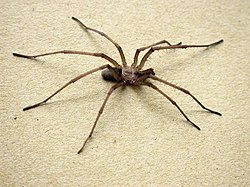| Crevice weavers Temporal range: | |
|---|---|
 | |
| male Kukulcania hibernalis | |
 | |
| Filistatid web | |
| Scientific classification | |
| Kingdom: | Animalia |
| Phylum: | Arthropoda |
| Subphylum: | Chelicerata |
| Class: | Arachnida |
| Order: | Araneae |
| Infraorder: | Araneomorphae |
| Family: | Filistatidae Ausserer, 1867 |
| Diversity | |
| 18 genera, 192 species | |
 | |
| blue: reported countries (WSC) green: observation hotspots (iNaturalist) | |
Crevice weaver spiders (Filistatidae) comprise cribellate spiders with features that have been regarded as "primitive" for araneomorph spiders. They are weavers of funnel or tube webs. The family contains 18 genera and more than 120 described species worldwide.


